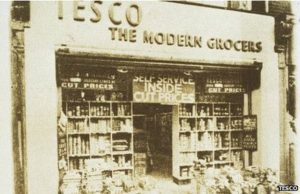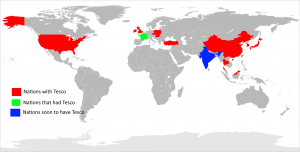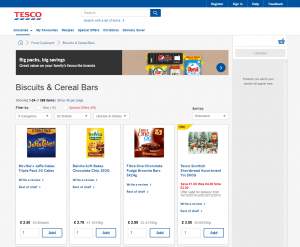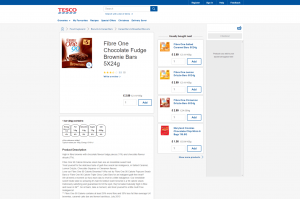

Tesco boasts an impressive history in the UK and abroad. Over the years, the grocery goliath has achieved continued success by remaining at the forefront of retail trends, including everything from self-service shopping to international expansion. More recently, Tesco has made its mark with a sophisticated online grocery strategy that enables seamless digital shopping. There’s a lot that can be gleaned from Tesco’s eCommerce efforts. In this Tesco case study, we highlight the retailer’s long-term emphasis on customer service, which can be seen not only in its physical locations but also in its eCommerce strategy.
A Brief History of Tesco
To understand current growth and successes and why they warrant a Tesco case study, it helps to understand the retailer’s history. Founded in 1919, the company initially consisted of a group of high-performing market stalls. Founder Jack Cohen conceived the idea shortly after leaving the Royal Flying Corps as World War I drew to a close. He used demobilization funds known as “demob money” to purchase surpluses of fish paste and golden syrup.

Tesco’s initial success could largely be attributed to Cohen’s understanding of mass-market sales. In a time of strict austerity, he employed a rigid business model of “stack ’em high, sell ’em low.” The brand also set itself apart by embracing a self-service approach, which, at the time, was rare in the UK. Following the introduction of its first supermarket in 1956, the retailer entered an era of rapid growth.
After emerging as the UK’s preeminent grocery chain, Tesco released the revolutionary Clubcard. During the 1990s, the chain expanded to include thousands of international locations. This was quickly followed by investments in internet retailing, which led to the chain’s current status as a top eCommerce grocer, netting £1.3 billion in pre-tax profits for the year ending in February 2018.
Tesco’s and World’s First Virtual Store

In 2011 Tesco was the first-ever retailer building the world’s 1st virtual grocery store in South Korea. The experiment took place in a subway station and the results were tremendous: the number of new registered members rose by +76%, online sales increased by +130% and Tesco became South Korea’s no1 online grocery retailer, outranking its rivals e-mart, so this experiment was one of the first key steps towards Tesco’s digital transformation.. After this phenomenal success, Tesco opened its first European virtual grocery shop in Gatwick Airport, UK. See how they did it in this brilliant video:
Tesco and Scandals

Tesco has occasionally suffered controversy in the last several decades, with 2 shocking moments that everyone remembers:
- The Horse Meat Scandal: Back in February 2013, several products believed to consist entirely of beef were found to contain horse meat. The Food Safety Authority of Ireland tested a range of cheap frozen beefburgers and it found that Tesco’s sample contained 29% horse instead of beef. The retailer made every effort to appease concerned customers. One of which included a notable promise to tighten up its supply chain and purchase a more significant share of its meat from the UK. Such efforts have likely played into the grocery chain’s recent logistics successes.
- The Accounting scandal: It was 2014 when the news dropped like a bomb: an FTSE 100 firm could get away with “cooking the books”. The company admitted submitting overstated profits by £250 million. The results? £2 billion off the supermarket’s share price in one day.
How Tesco thrived in the COVID-19 area

During Q1 2021, Tesco reported that the sales from its online store were “remarkably higher” than before the Covid-19 crisis. As Internet Retailing mentions, Tesco’s sales increased by +22% in 2020, even though the physical stores and hospitality re-opened at some point. It is believed that this success was a result of Tesco’s recent delivery enhancements and doers mentality, implemented during the first lockdown.
It’s revenue analysis shows that 1.3m online orders were conducted only in spring 2021. This means that the total number of transactions was 81.6% higher than the same period in 2019 (a before Covid-19 year), proving that Tesco actually turned COVID-19 into an opportunity for its business, achieving memorable results by quickly adjusting its business model to the pandemic’s needs.
How Tesco Became a Retail Case Study Favorite

Despite the horsemeat scandal, Tesco remains a customer favorite throughout the United Kingdom. The Tesco case study has become a common phenomenon, as the chain boasts several unique strengths worth emulating on a broad scale.
Over the years, the retailer has shifted its original “stack ’em high, sell ’em low” approach. While affordability remains a priority, Tesco did not pursue it to the detriment of quality. Instead, it combines reasonable prices with exceptional convenience and customer service. This can be seen in physical stores and eCommerce alike.
Excellent Customer Service
Strong customer service lies at the heart of Tesco’s sustained success. The retailer employs a variety of initiatives to keep consumers happy. Customer-oriented product development, for example, ensures that all stores are stocked with the items visitors actually want. This development process includes rigorous consumer testing to ensure that new products and services are well-received. Customized stores lend further appeal; each is designed based on carefully analyzed demographics.
Quality customer service means making accommodations for all consumers—including those with special needs. Tesco accomplishes this through the use of sunflower lanyards, which allow customers with hidden disabilities to secure additional assistance discreetly. The chain also provides induction loops for hard-of-hearing customers, as well as helpful visual guides for consumers with autism.
Ultimately, Tesco’s impressive customer service derives from its top-down approach, in which a commitment to customer satisfaction permeates every element of the company’s culture. Insight Traction’s Jeremy Garlick tells The Grocer that the key to large-scale retail success lies in “understanding your customers, anticipating their needs, and giving them what they will value.” Tesco checks off all these boxes. This is true both in stores and with its website, which uses an intuitive layout to ensure that customers can quickly access the products and services they desire.
Product Diversification

Tesco may be best known as a grocery chain, but the retailer provides a surprising array of products and services. It aims to serve as the ultimate one-stop-shop for those who prioritize convenience and quality above all else. Customers can expect to find a collection of produce, dry goods, frozen products, and more. Toiletries, household products, pet food, and even apparel can also be located within Tesco stores and on the retailer’s eCommerce website.
Beyond its many product offerings, Tesco also provides a few key services to enhance customer convenience. Tesco Bank, for example, offers everything from credit cards to pet insurance. These digital offerings play largely into Tesco’s eCommerce strategy, with banking customers capable of accessing their account information online.
Fine-Tuned Logistics
Quality customer service is not possible without an effective logistics and supply chain strategy. Strong relationships with suppliers are essential, especially as Tesco seeks to diversify its already vast product collection further. Efficient routes ensure that produce and other time-sensitive products arrive promptly in stores—and are quickly distributed to customers taking advantage of the chain’s affordable home delivery program.
Ongoing investments in telematics promise to further improve Tesco’s already fine-tuned supply chain. New monitoring tools offer greater insight into the trip status and real-time decision-making—and how these elements play into both profit margins and long-term customer satisfaction.
Digital customers, in particular, appreciate Tesco’s tight supply chain. When they order items online, they can rest assured, knowing that their favorite products will consistently be in stock. What’s more, online customers feel confident that delivered items will be fresh and of exceptional quality.
Insane International Expansion

Tesco may currently dominate the UK grocery market, but it’s also an international force. While the retailer pulled out of the United States in 2014, it has enjoyed sustained growth in Eastern Europe and Thailand.
Just as Tesco targets its international in-store efforts to reflect local populations, it designs its global eCommerce strategy around a diverse consumer base. Different websites are offered in each target country, with text provided in both English and the respective region’s primary language.
Customer Loyalty
Brands such as Costco and Amazon prove that customer loyalty can pay dividends for a company’s bottom line. Tesco demonstrated this long ago with the Clubcard, which encourages customers to prioritize the chain over competitors.
Today, the Clubcard continues to play a crucial role in Tesco’s success. Further transformation is in store, as Tesco recently unveiled a £7.99 per month subscription service called Clubcard Plus. Subscribers will receive significant discounts above and beyond those offered through the traditional Clubcard, including a permanent 10 percent off many of the store’s most beloved brands. Given the current popularity of subscription services, this could prove an excellent opportunity to get existing customers even more enmeshed in the Tesco ecosystem and more responsive to eCommerce marketing automation efforts.
Tesco’s eCommerce Website
Tesco’s eCommerce strategy reflects the brand’s commitment to value and convenience. These priorities are evident in everything from the logo to the images and even the general layout. Website visits are just as efficient and orderly as in-person purchases at Tesco’s physical locations. Tesco’s website, like its stores, may not be fancy—but it gets the job done. In this Tesco case study, we’ve analyzed several of the key eCommerce strategies that help Tesco’s page stand out in a competitive digital marketplace, as well as a few areas that warrant improvement.
Analyzing Tesco’s Homepage

What We Liked
- Easy to navigate. Today’s impatient customers demand easy-to-navigate websites that almost instantly get them from point A to point B. Tesco’s homepage appeals greatly to convenience-oriented online shoppers, who can quickly find desired products via a simple search tool. Headings highlight main categories, including groceries, clothing, banking, and even recipes.
- Visually-appealing fullscreen displays. Rather than distract website visitors with several separate visuals, Tesco’s website maintains a single, but decidedly bold display. This impactful background stretches across the entire screen and is layered behind text and customer prompts. The homepage, featuring fresh produce, has eye-catching graphics that reflect the commitment to quality that emerges in every Tesco case study
- Minimalist, but not dull. Minimalist displays dominate modern web design. Sometimes, however, white space feels excessive. Tesco strikes an ideal balance by keeping clutter to a minimum without relying on a bare-bones approach.
- Easy logo identification. Customers can always spot the Tesco logo in the upper left-hand corner, surrounded by just enough white space to ensure that it stands out.
What We Didn’t Like
- Customer testimonials. Reviews from happy customers may prove desirable in some contexts, but there is a time and a place. These particular testimonials take up the page’s most prominent space, which could be better served by showcasing exciting deals or products.
- Tabs that open into new pages. Ideally, when clicking on a link that appears to be a tab (such as the Delivery Saver tab), the new content should open in the same page, instead of loading an entirely new page.
Analyzing Tesco’s Category Page

What We Liked
- Sticky cart functionality. As shoppers browse the website and add items to their carts, they can keep track of these intended purchases on the right side of the screen. This intuitive design allows for a seamless Tesco checkout process, thereby increasing the likelihood of conversion.
- Variety of filters. A wide array of filters are provided to allow customers to browse through products based on brands and categories. Furthermore, customers can customize their browsing according to specific dietary filters such as vegan or Halal. This plays into Tesco’s overarching emphasis on personalized shopping.
- Usually bought next. Situated at the bottom of each category page, this helpful section makes it easy to pair similar grocery items. This increases customer convenience while also helping to improve sales and final revenue on Tesco’s end.
What We Didn’t
- Difficult filter navigation. There’s a lot to be said for the variety of filters at customers’ disposal, but the actual process of navigating them can prove complicated, particularly
compared to competitor websites. - Navigating to different items within categories. Navigation can prove surprisingly difficult for those browsing various items within categories. The constant need to return to the homepage could quickly grate on otherwise amenable customers.
- Lack of search functionality within categories. Items cannot be sought via keywords within specific category pages. All searches must be completed using the main search bar on the top of each page. For many users, this may represent the website’s greatest weakness, as keyword category searches are an expected feature among competitors.
Analyzing Tesco’s Product Page

What We Liked
- Time-limited delivery notice. Produce delivery is inherently time-sensitive, as are several other services that Tesco provides via its website. The retailer harnesses the power of time-limited delivery notices to ensure that consumers use products when they’re freshest and most appealing.
- A wealth of product information. Product pages contain a wealth of relevant information, including everything consumers could possibly want to know about each item’s nutritional content, country of origin, and even preparation instructions.
- Customer reviews. Shoppers on the fence about a particular product can read customer reviews to get a better idea of whether they actually want to invest in said item. With a wealth of alternatives available, they can take solace in knowing that other options are always on hand.
What We Didn’t
- Nondescript Add to Cart button. Tesco’s approach for adding options to its carts may get the job done, but this could be an excellent opportunity for adding a bit of visual flair
without detracting from the website’s minimalist approach. - Too much text combined with too small product images. Many shoppers regularly purchase items without actually knowing their names. Rather, they focus on packaging.
Tesco’s small pictures make it difficult for these shoppers to identify the elusive products they want. Some may end up with unexpected and unwelcome surprises upon delivery. - Too much information. While it’s useful to know the origin of each item, including the exact address may seem like overkill to some users. This detailed information detracts from Tesco’s otherwise streamlined product pages.
Analyzing Tesco’s Checkout Process

What We Liked
- Numerous delivery slots are available. A variety of helpful slots for receiving grocery deliveries are provided on an hourly basis throughout the day. This dramatically improves customer convenience, particularly for those who work long hours and might not be available for the limited delivery times provided by some of Tesco’s key competitors.
- Automatic Click+Collect locations. Those who opt to collect deliveries at Tesco stores can look to this feature to automatically display a variety of nearby locations. This makes in-person delivery collection nearly as convenient as Tesco’s impressive delivery setup.
- Several Delivery plans are available. Shoppers who aren’t in a big hurry can elect to have their orders delivered mid-week for a reduced charge. Meanwhile, demanding customers are asked to pay extra for same-day delivery. Customers love options, particularly when they believe those options prompt significant savings.
What We Didn’t
- Oddly unavailable Click+Collect hours. Shoppers who plan their grocery pickup several days out will be surprised to find that some collection times up to a week out are unavailable. Hence, while Click+Collect provides exceptional functionality for last-minute pickups, it’s not always ideal for those who prefer to schedule in advance.
Interesting Technologies That Tesco’s UK Site Uses
Eager to learn more about Tesco’s strategy and the technologic functionalities that make Tesco’s website so easy to use, we harnessed the power of BuiltWith to scan the website. A few of the notable technologies we spotted include:
- Omniture SiteCatalyst. Tesco’s web analytics are provided by Adobe’s Omniture SiteCatalyst — an expensive, complex system when compared to its main competition (Google Analytics). If set up correctly, however, Omniture SiteCatalyst provides excellent customer support.
- Hotjar. One of the world’s most famous screen recording and heatmaps tools, Hotjar offers a range of behavior analytic services ideal for businesses such as Tesco, which aim for a targeted approach based on actual customer behavior.
- Optimizely. This top experimentation platform plays significantly into modern web innovation. Despite its name, however, Optimizely may increase page load times throughout the Tesco site.
- OpinionLab. OpinionLab does an admirable job of collecting customer feedback on every aspect of Tesco’s webpage. This allows Tesco to customize better its web offerings based on actual customer opinions
- SendinBlue. User experience is a huge point of contention for SaaS provider Sendinblue. Clients regularly struggle with forms, automation, and APIs. ContactPigeon may prove a more customer-oriented alternative.
Some of these eCommerce tools are also used by John Lewis, UK’s homeware giant, so we do realize that these technologies play also an important part in a retailer’s business model and online success.
Impressive Tesco Stats You May Not Know
- As of 2019, Tesco boasted over 6,800 shops worldwide.
- Tesco currently employs over 450,000 employees around the world.
- Tesco had a 26.9 percent market share in the UK in 2019.
- Of the UK shoppers who primarily visit Aldi, 45 percent highlight
- Tesco as their main secondary store.
Breaking Tesco News:
- Tesco changes bonus rules after Ocado success hits pay – Read more here
- Coronavirus: The weekly shop is back in fashion, says Tesco boss – Read more here
- Tesco launches half price clothing sale – but some slam the company as ‘irresponsible’ – Read more here
- Tesco, Sainsbury’s, Asda and Aldi put restrictions on items amid stockpiling – Read more here
- Tesco sells its Thai and Malaysian operations to CP Group. Learn more here
- In September 2021 Tesco launched a zero-waste shopping service, providing customers with containers. – Learn more here.
FAQ on Tesco

When did Tesco begin?
Tesco technically began in 1919 but did not receive its current name until 1924. The company originally consisted of market stalls, with the first shop that might be recognizable to modern consumers not opening until 1931.
What made Tesco successful?
Tesco is popular in the UK and abroad due to its combined emphasis on quality, convenience, and affordability. The Clubcard plays a huge role in the retail chain’s continued popularity, as it keeps customers coming back for deals. So why is Tesco so successful? It is because of its customer-centric approach, that it gradually helped Tesco to develop a very loyal customer base and equity and a very powerful multinational brand.
Who is Tesco’s owner?
Tesco is currently experiencing a shakeup in leadership. After serving as CEO for several years, Dave Lewis announced his resignation in 2019. He will be replaced by Ken Murphy in 2020. John Allan currently serves as the chain’s non-executive chairman.
What is Tesco industry sector?
Tesco PLC is a retail company. Its core business is grocery retail but they also are in retail banking and assurance industries as well, as part of their product diversification strategy.
How many stores Tesco has?
Tesco has 6993 stores in 12 countries
How profitable is Tesco?
Tesco’s revenue grew by +12% YoY in 2019 hitting £63.91 billion.
Is Tesco in the public or private sector?
While Tesco was initially a privately-held company, it became a public limited company (PLC) in 1947 and has continued to operate under this approach. However, despite Tesco’s status as a PLC, it remains firmly part of the private sector.
The Tesco Case Study: An overnight Success?
As our analysis showed, a variety of factors play into Tesco’s success. The retailer has a long history of using cutting-edge practices (like the virtual store mentioned above) to set itself apart from the competition. Much of its current success, however, relies on its perception as a convenient and affordable chain.
Tesco’s success is not a matter of luck. On its website and in its stores, the retailer emphasizes customer-oriented practices designed to make every shopping experience as seamless and as enjoyable as possible. This simple yet effective approach promises to keep the retailer at the forefront of the grocery industry in years to come.
If you’re looking to emulate the qualities evident in this Tesco case study, don’t hesitate to get in touch. Contact us today to book a free marketing automation consultation.




